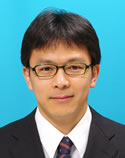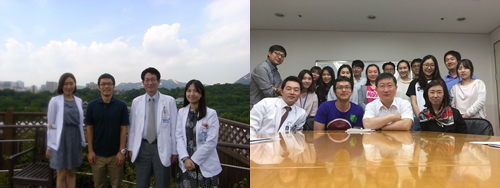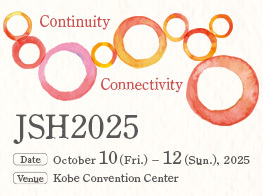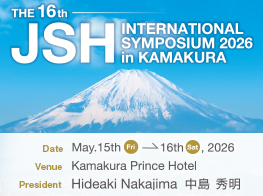 |
Hisayoshi Hashimoto Molecular and Cellular Medicine, National Cancer Center Research Institute |
Host supervisor/Mentor of the project: Sung Soo Yoon, M.D., Ph.D.
Department of Internal Medicine, Hematology/Oncology, Seoul National University Hospital
Home mentor: Yuji Heike, M.D, Ph.D.
Immunotherapy and Cell Therapy Service, St. Luke's International Hospital
Research Project
Patient characteristics of follicular lymphoma and adult T-cell leukemia/lymphoma in Korea
GENERAL REPORT
1. Host Institute: Seoul National University Hospital
Seoul National University Hospital is located in the center of Seoul city, next to Changdeokgung Palace. It consists of Main hospital, Children’s hospital and Cancer hospital. It is one of the largest hospitals in Seoul, having 1307 employed doctors and holding 1782 beds including ICU and NICU, as of November 31, 2014. Its origin goes back to April 14, 1885 when Jejungwon was established as the first modern public hospital of western medicine in Korea. Its history also includes strong reflection of Japanese government in early-20th century. After the annexation of Korea by Japan in 1910, all fields constituting hospitals and medical education were changed into a system focused on the Japanese. Major staff members of hospitals and schools came to be replaced by the Japanese at that time. In 1978, the Hospital Affiliated with the College of Medicine of Seoul National University was reorganized into a special corporate body of Seoul National University Hospital Foundation to raise medical service in South Korea to world-class levels by maximizing its autonomy and efficiency. Since then, Seoul National University Hospital has been officially and legally recognized as the center of national medical service. There is a museum of medicine inside the hospital site, exhibiting its whole history.
2. My research topic: follicular lymphoma in Korea
1) Background
Malignant lymphoma has its difference in epidemiology and etiology in different areas around the world. The overall incidence of malignant lymphoma in Asia is lower compared with western countries. The subtype distribution of malignant lymphoma also reveals striking geographic variation. Asians typically have higher rates of aggressive Non-Hodgkin Lymphoma (NHL), T/NK-cell lymphoma, while Hodgkin’s Lymphoma (HL) is relatively rare.
In recent decades, the incidence rates of all subtypes of NHL have increased worldwide in both genders, particularly in the elderly. In a previous study in Japan, the incidence rate of follicular lymphoma (FL) was 6.7% (1994-1996), but a recent study they found a relatively high rate of FL (19%, 2001-2006) similar to that of western countries (11-30%). The reasons for this increase were speculated as follows; first, there have been improvements in the diagnostic accuracy for this subtype due to the development of comprehensive diagnostic methods including flow cytometry, immunohistochemistry, chromosome testing, gene testing and FISH. Second, the previous study might have underestimated the frequency of FL because it counted loss the initial visit cases at smaller hospitals if they were not consulted to large hospitals. Third, westernization of Japanese lifestyle may have contributed. The rate of follicular lymphoma for Japanese-Americans in Hawaii was reported to be relatively high compared to that of native Japanese and close to that of North American Caucasians. On the other hand, in Korea, reported frequencies of FL were 2.3% (1976-1986), 1.6% (1990), 6.2% (1994-1996) and 2.9% (2005-2006), which did not hold an obvious increasing tendency. The discrepancy of the prevalence in FL between Korea and Japan remains unexplained.
2) Purpose
Why the prevalence of FL between Korea and Japan highly differs? Although family history increases the risk of FL in people who have relatives receiving the same diagnosis, hereditary factors are hypothesized to explain only small percentages. Indeed, a previous study speculated that the relatively low incidence of FL in Asian populations was caused not by a lower frequency of bcl-2 rearrangements in healthy populations but by inhibited distinct subsequent molecular pathways. Although the mechanism is unknown, environmental factors such as diet habits and smoking play an important role in tumorigenesis of FL. However, the mechanisms by which genetic predisposition or gene-environment interactions may enhance or reduce the risk of developing FL remains largely unexplored area.
Thus, I plan to investigate the clinical data of patients with follicular lymphoma in Korea retrospectively and compare with counterpart data in Japan.
3) Daily time schedule at Seoul National University Hospital
I followed the outpatient clinic and inpatient ward round by prof. Yoon and joined every clinical conference involving the hematology division. Weekly time schedule is as follows; Monday: clinical research meeting at 8:30, ward round after that and outpatient clinic from 11:30 to around 13:00, Tuesday: infectious disease meeting at 9:00 and outpatient clinic from 12:00 to around 18:00, Wednesday: ward round at 9:00, outpatient clinic from 11:30 to around 13:00 and research lab meeting at 18:00 (2 speakers present their updating research data), Thursday: outpatient clinic from 9:00 to around 14:00, Friday: ward round at 9:00, outpatient clinic from 11:30 to around 13:00, clinical lecture for resident doctors at noon. I had a chance to present my research data obtained in Japan at a research lab meeting held on Wednesday evening. Then I discussed them with Prof. Yoon, Prof. Koh, Dr. Jung at Dongguk University and all the lab members. Except for the outpatient clinic, ward round and conferences, I gathered the retrospective data of 140 patients with follicular lymphoma diagnosed at Seoul National University Hospital between 2005 and 2015. In addition, Dr. Oh at Dong-A University kindly will offer me a nationwide retrospective data to conduct a collaborative study between Korea and Japan. During this stay in Korea, I visited Busan to meet Dr. Oh and he kindly came to Seoul and talked about this collaborative research more in detail. This study is currently progressing, and I hope to report the results in the near future.
3. Summary of the Fellowship Exchange Program
My stay in Korea for this research was only for two weeks. Because the majority of my research in Korea was chart-reviewing, I sometimes needed translation about Korean language. All lab members kindly taught me how to handle with electric chart system at the hospital and sometimes translated Korean into English for me. Thanks to their help, I managed to review all the required data within my stay period. In addition, regardless of short-term stay, I was able to get used to Korean style quite easily and enjoyed the Korean culture besides research at the hospital, thanks to many Korean friends. I really appreciate their hospitality which I suggest Japanese should learn from them.
What is the most precious I achieved during this stay is the connection with many Korean doctors and researchers. I promised with them to conduct a collaborative research, hopefully a clinical trial in the future. I would like to realize this dream by making a continuous effort.
Unfortunately I totally cannot understand Korean language. I realized many times the necessity to learn Korean language in order to fit into them. At least, I should have learned several key phrases and sentences for greetings or thanks as past awardees of this program described. So I again recommend the next awardee to study Korean, needless to say English.
4. Acknowledgments
First of all, I would like to thank Prof. Sung-Soo Yoon in the Department of Internal Medicine, Hematology/Oncology for total arrangement of my stay in Hospital and Laboratory. I also would like to thank Prof. Park and Prof. Koh in the Department of Internal Medicine for giving me educational opportunities. Moreover, I would like to appreciate Dr. Kim, a resident doctor, and Dr. Su, a fellow doctor, for supporting my clinical participation. Furthermore, I would like to give my thanks to all the lab members, especially Woo-June, Hana, Yujin at the Cancer Research Institute of Seoul National University, for supporting my research. Finally, I would like to express my gratitude to the Japanese Society of Hematology and Korean Society of Hematology for giving me this special opportunity.

<Return toJSH-KSH Fellowship Exchange Program Scientific Report>





